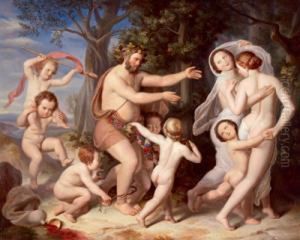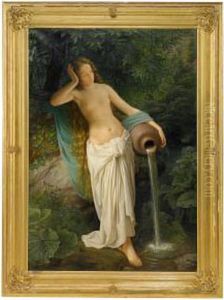Edouard Steinbruck Paintings
Edouard Steinbrück, born in 1810 in Magdeburg, Germany, was a significant figure in the 19th-century German art scene, known primarily for his contributions to painting. Despite not being as widely recognized as some of his contemporaries, Steinbrück's work encapsulates the Romantic spirit that permeated much of European art during his lifetime. His artistic journey is a reflection of the broader shifts in European art, moving from the neoclassical towards romanticism, and eventually participating in the early conversations of modernism.
Steinbrück's early life was marked by traditional education in the arts. He received formal training at the prestigious Prussian Academy of Arts, where he was influenced by the teachings of notable artists and instructors of the time. His education was not merely technical; it imbued him with a deep appreciation for the emotional and philosophical depth of art, which would become a hallmark of his later works. Steinbrück's paintings often depicted scenes of dramatic landscapes, historical narratives, and were imbued with a sense of emotional depth and sublime beauty characteristic of Romanticism. This period in art emphasized emotion and individualism, a reaction against the industrial revolution and the rigid structures of neoclassicism.
Throughout his career, Steinbrück traveled extensively across Europe, drawing inspiration from the varied landscapes and historical sites he visited. These travels significantly influenced his artistic output, allowing him to imbue his works with a sense of place and time that was rare among his peers. Despite his talent and the quality of his work, Steinbrück never achieved the level of fame and recognition enjoyed by some of his contemporaries. Nonetheless, his contributions to the German Romantic movement remain important.
Edouard Steinbrück's later years were spent in relative obscurity, and he passed away in 1882. Despite the lack of widespread acclaim during his lifetime, subsequent generations have come to appreciate his work for its emotional depth and technical mastery. Today, Steinbrück's paintings can be found in several important collections, and he is recognized as a significant, if underappreciated, figure in the transition from neoclassical to romantic art in 19th-century Germany. His legacy is that of a dedicated artist who sought to capture the sublime and emotional intensity of the world around him, paving the way for future generations to explore the depths of romantic expression in art.




